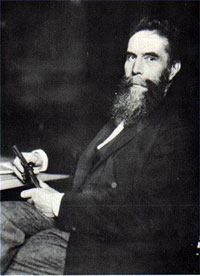History of X-ray imaging
 Dr. Willem Roentgen's discovery of X-rays in late 1895, in Wurtzburg, Germany, serves as a classic example of an accidental invention.
Dr. Willem Roentgen's discovery of X-rays in late 1895, in Wurtzburg, Germany, serves as a classic example of an accidental invention.
Roentgen was carrying out experiments with a Crookes tube, a fairly common research apparatus of the time. (A Crookes tube was a glass chamber, evacuated off air as well as possible at the time, with two pieces of enclosed metal in each end which were connected across a battery.) As Roentgen applied large voltages to the device to study the behaviour of electrons emitted from the metal, he noticed that a piece of phosphorus material, situated elsewhere in the room, glowed!
Puzzled by the glow, Roentgen went on to lock himself in the laboratory for the following few weeks to further investigate the mysterious emissions. His tried to block the emissions by covering the tube first by a piece of cardboard and then by a piece of wood only to find that the phosphorus still glowed. He also noticed that when he held his hand between the tube and the phosphorus, the light given off seemed to present an image of his hand. To convince himself he wasn't going crazy, Roentgen recorded such images on pieces of film thus obtaining the first X-ray images of human anatomy.
What caused the phosphorus to glow? What was the mysterious emission from the tube that penetrated not only cardboard and wood but also human tissue? The answer, of course, was a form of invisible, high energy radiation. When a large potential difference (e.g. a large battery) is applied between the electrodes (pieces of metal) in the Crookes tube, electrons are released from the negative electrode. These electrons from this negative electrode (cathode) are atttracted towards the second, positive electrode (anode) with such force that they acquire great speed and energy. When an electron bombards the positive electrode its energy is transferred to the nucleus of the metal atom. This energy is then re-released from the nucleus in a form of radiation that we now call X-rays.
This radiative process is similar to what happens when light is produced except that light results from atomic rather than nucleic excitations. In fact, both light and X-rays are part of the same physical phenomenon: electromagnetic radiation. X-rays can simply be thought of as high energy (i.e. very short wavelength or high frequency) light.
It is because of their high energy that X-rays can penetrate through many objects. However there are differences in penetration through different materials due to the differences in the material densities. For example, X-rays can penetrate through fat/muscle easier than through bone, which is the basis for imaging the body with X-rays.
Once Roentgen decided he had proven the existence of new, invisible rays, he captured a number of X-ray images on film and sent them to various scientists and organizations to claim his stake in this discovery. Roentgen's first experiments took place in November 1895, the communications went out by January of 1896, and by February of that year a number of other scientist, who possessed exactly identical equipment, were able to duplicate Roentgen's results.
The discovery caught on like fire and in a few months X-ray tubes were set up to image the public for both medical and entertainment purposes. The ability of X-rays to shrink tumours was also soon discovered. Thus, in addition to acquisition of diagnostic medical images, X-rays began to be used for radiation therapy.
There were great misconceptions about X-rays in the early days. For example, modest ladies were worried about their virtue due to rumours of X-ray vision; X-ray imaging was a great attraction at freak shows; and photography studios offered X-ray portraits. Over time the potential health hazards became better understood and use of X-ray tubes shifted over to medical professionals -- although X-ray imaging continued to be used in shoe stores up to the 1950's to study the fit of footwear!


